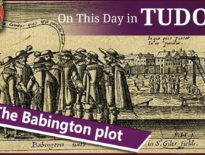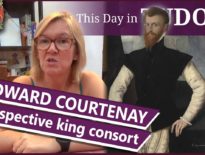On this day in Tudor history, 19th September 1560, explorer, navigator and privateer Thomas Cavendish was baptised at St Martin's Church, Trimley St Martin in Suffolk.
Cavendish is known for his imitation of Sir Francis Drake's circumnavigation of the globe, which he undertook in 1586, and for being the first Englishman to explore the island of St Helena, in the mid-Atlantic, but he also had a reputation as a spendthrift and his final voyage was a failure.
Find out more about Thomas Cavendish in today's talk.
Also on this day in Tudor history, 19th September 1555, in the reign of the Catholic Queen Mary I, Protestants Robert Glover and Cornelius Bungey, were burned at the stake for heresy in Coventry. They were two of twelve martyrs burned in the city between 1511 and 1555. Find out more about them and Glover's experience as he was taken to the site of execution in last year’s video:
Also on this day in history:
- 1551 – Birth of Henry III of France. He was born at the Château de Fontainebleau, and was the fourth son of King Henry II and Catherine de' Medici. He was King of France from 1574 to 1589, succeeding his brother, Charles IX.
- 1580 - Catherine Bertie (née Willoughby and previous married name Brandon) died after a long illness. She was buried in Spilsby church, Lincolnshire. Catherine's first husband was Charles Brandon, Duke of Suffolk, and her second husband was Richard Bertie.
Transcript:
On this day in Tudor history, 19th September 1560, explorer, navigator and privateer Thomas Cavendish was baptised at St Martin's Church, Trimley St Martin in Suffolk.
Cavendish is known for his imitation of Sir Francis Drake's circumnavigation of the globe, which he undertook in 1586, and for being the first Englishman to explore the island of St Helena, in the mid-Atlantic.
Let me give you a bit more information about this explorer…
• Thomas Cavendish was the son of William Cavendish of Grimston Hall, Trimley St Martin, and his wife, Mary Wentworth. Cavendish’s father died in 1572 and Thomas Wentworth, 2nd Baron Wentworth, became his legal guardian.
• Cavendish was educated at Corpus Christi College, Cambridge, and then entered Gray’s Inn, one of London’s inns of the court.
• He got a reputation for being a spendthrift and in the early 1580s was taken to court for non-payment of debts.
• In the 1580s, Sir Walter Ralegh acted as his patron and at Durham House, Ralegh’s London home, Cavendish was taught navigation by men such as Thomas Harriot.
• In 1585, Cavendish was made high marshal under Richard Grenville for an expedition to Virginia. His steward, Henry Seckford, either bought or fitted out the Elizabeth, a pinnace, which joined the fleet setting out from Plymouth on 9th April 1585. A storm scattered the fleet, but even though he was a novice navigator, Cavendish was able to rendezvous with Grenville in Puerto Rica, as arranged just eight days later. There, Cavendish became friends with Ralph Lane, who was due to become governor of Virginia, and Lane wrote of Cavendish, saying “'Yt ys not possible for men to beehave themselves more fayethfully and more industryously in an Accion especially Master Candysshe our High Marshall”.
• After returning to England with Grenville, Cavendish set about preparing for another voyage, ordering a galleon and a pinnace, Desire and the Hugh Gallant, supported by men including merchant John Foxe, Sir Walter Ralegh, Sir Francis Walsingham. Lord Hundson, Sir George Carey, admiralty judge Julius Caesar, and the Earl of Cumberland. Cavendish also collected charts and employed men who’d served under Sir Francis Drake, as well as a mathematician and Portuguese pilots. The fleet set sail from Plymouth on 21st July 1586 with 3 ships and 123 men aiming to open up trade with the East and break the Spanish monopoly there, and to find locations for new colonies in South America, as well as raiding Spanish ports and ships.
• Cavendish reached Brazil by 21st October and then entered the Strait of Magellan by early January 1587, clearing it by 24th February. The master of the Hugh Gallant was killed in an attack by Spaniards, along with several others, but the English fleet were also able to loot and burn Spanish vessels and towns, and capture ships off the coast of South America. He went on to explore the Philippines and the Chinese coast before returning to England in September 1588, exploring the island of St Helena on the way. He took back with him a Great Map of China. His circumnavigation had been quicker than Drake’s, taking two years and 49 days.
• In November 1588, he received Queen Elizabeth I on board the Desire, but was not knighted. He passed on vital information gleaned on his travels to Sir Francis Walsingham, who, in return, ordered his physician to treat Cavendish who was ill.
• His return was marred by Judge Julius Caesar threatening court action in 1589 over Cavendish’s delay in paying him his profit, and the subsequent impounding of the Desire, which Cavendish had just refurbished. Her pilot was also accused of piracy and the bond of £2000 which Cavendish had paid to the high court of admiralty to ensure that she would only attack Spanish vessels on the voyage was forfeited. This delayed Cavendish’s plans to return to the Far East.
• In 1591, the queen commissioned Cavendish for a voyage to the East, which he undertook with navigator John Davis, who wasn’t keen on the idea. Their departure was delayed by setbacks, for example, the arrest and imprisonment of one of Cavendish’s experience crew men. They finally set off on 26th August, sailing directly to Brazil. There were disagreements between Cavendish, his cousin John c*cke, and Davis, and the crews of their ships, with Davis requesting permission for his ship, the Daintie to return to England laden with sugar. The loss of this ship from the fleet meant Cavendish had to spend time building a replacement pinnace. He accused Davis of treachery while Davis’s supercargo accused Cavendish of negligence.
• Storms caused damage to the fleet and Cavendish’s newly built pinnace, the Crow, was completely lost. The Daintie headed home while Cavendish rendezvoused with the rest of his fleet at Port Desire. The fleet suffered further damage in storms just before they entered the Strait of Magellan in April 1592 and then the arrival of winter, combined with the fleet’s lack of supplies, led to 40 men dying each week. Cavendish decided that they should head for the Philippines, although Davis disagreed, but they were again beset by storms and driven back to the Port of Desire. Davis set about refitting the Desire to attempt to sail through the Strait of Magellan once again while Cavendish headed for Santos. Shortage of food and a discontented crew led to delays in Cavendish’s plans to return to the Strait and then on to St Helena. Cavendish never made it home, dying a broken man in May or June 1592. In his will, Cavendish attacked John Davis, calling him a villain and blaming him for their failed mission.
• Although he died on a failed mission, Thomas Cavendish had completed a successful circumnavigation, he’d taken home a map of China, he’d tried to establish new trade in Brazil, around the River Plate and in the Far East, and he had shown himself to be a good navigator and a man able to get backing and support for his missions.



Leave a Reply